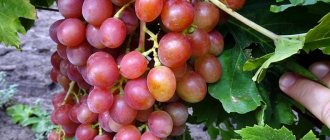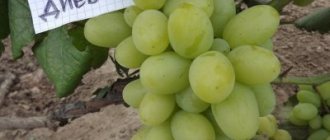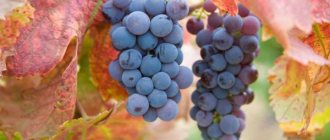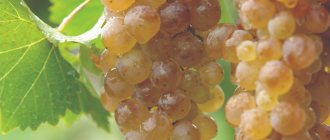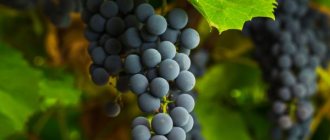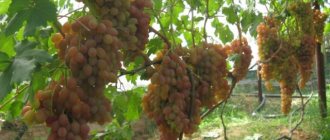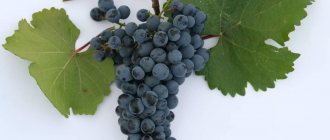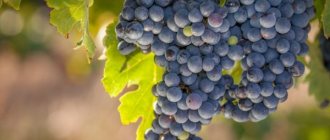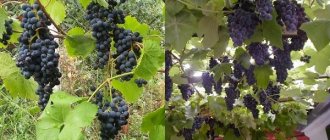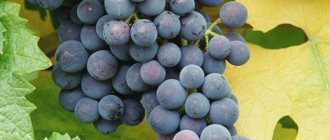Fruits and berries » Grapes
0
767
Article rating
Kira Stoletova
Zarnitsa grapes are one of the best varieties to grow. The variety is hybrid. It was developed by combining Radiant Kishmish and White Grapes. The variety belongs to the white table family.
Zarnitsa grape variety
Description of the variety
Sweet berry.
Early ripening.
Good presentation.
The variety appeared during the crossing of the Talisman and Kishmish varieties by an inexperienced breeder, Viktor Krainov.
He dreamed of developing a variety that could develop well in humid conditions and produce an excellent harvest . In the process of experimentation, Arcadia early appeared, which fully met all the goals set.
Characteristic
Zarnitsa berries are characterized by a white-yellow color at the initial stage of ripening.
The grape has existed as a separate variety for only 22 years and belongs to the early table varieties.
It has become popular among gardeners and is in demand for growing in summer cottages or the private sector.
Bush
The Zarnitsa bush is characterized by increased intensity of crown development and growth; shoots begin to ripen quite early.
The bush is equally vigorous in grafted and in its own root culture.
- The leaves are not very large and have dissections on the upper side.
- The underside , in turn, is covered with soft fluff.
- The question of pollination of this variety does not arise, since the inflorescences are bisexual.
- The maximum load on the entire bush is 23–25 shoots and 40 eyes.
Bunches and berries
Cone-shaped clusters can reach enormous sizes.
A bunch of impressive sizes.
- The weight of one bunch can vary from 500 g to 1.5 kg .
- The berries are ovoid and weigh 9–10 g.
- The pulp is quite soft, but does not spread.
- The peel is a little elastic and thin, so it doesn’t affect the taste.
The taste of the berries is very juicy and sweet, with a honey aroma.
Appearance of a ripe berry.
When fully ripe, the berries are amber in color and have an excellent presentation. Sugar content is 17–19%, and acidity is no more than 6 g/l . During the ripening of the crop, gardeners note the absence of peas. This effect can occur when grown in very poor conditions and infertile soil.
Creator of grape masterpieces
Viktor Nikolaevich Krainov was one of the first among national breeders to achieve outstanding success in the selection of new hybrid forms of grapes. His contribution to the development of amateur selection and the popularization of viticulture is difficult to overestimate. Every year, the hybrid forms of grapes developed by him occupy more and more space in home vineyards and are already becoming in demand in industrial ones.
For many national breeders - winegrowers, for many years the best hybrid forms of Viktor Nikolaevich will remain the main guideline in their selection work. To surpass V.N. Krainov with your achievements is not just an end in itself, but a very significant stimulus for the creative process of every originator in viticulture, both folk and those awarded academic degrees.
As fate would have it, I took my last interview with Viktor Nikolaevich shortly before his death. On November 30, 2009, I visited him at his summer cottage in the city of Novocherkassk. Although Viktor Nikolaevich was not feeling very well, we still walked through his vineyard and checked the quality of the vines’ shelter for the winter. After inspecting the shelter of the vineyard, we sat down to rest on the porch of the dacha and I asked Viktor Nikolaevich to give an interview, which I wanted to publish in the press. He agreed to answer my questions.
— Viktor Nikolaevich, how did your passion for viticulture begin?
— Since I was fifteen years old, I have been taking care of the vineyard, since 1953, since then, when my father Nikolai Alekseevich, a retired colonel, retired to the reserve after completing his military service and devoted himself to viticulture, and naturally I became interested in this activity. In 1986, I purchased a dacha plot relatively close to my home on the banks of the Tuzla River, where we are now located. The dacha plot is located on the banks of a river in its floodplain, so spring and autumn frosts are frequent guests at my dacha, as are constant dew and fog. Therefore, it is actually possible to grow grapes on my plot that are not prone to cracking and rotting of the berries. When I planted my vineyard on this site, phylloxera had already been discovered in the vineyards of Novocherkassk, so I planted it with bushes on phylloxera-resistant rootstocks - CO4, Kober 5BB, which are currently the main rootstocks when growing new hybrid forms of grapes.
— Viktor Nikolaevich, when did you start breeding and why?
— In 1995 and 1996, on the advice of the leading specialist in grape breeding at VNIIViV named after. ME AND. Potapenko Ivan Aleksandrovich Kostrikin carried out his first crossings in order to obtain seeds of hybrid forms of grapes. The grape varieties Talisman + Tomaisky, Talisman + Autumn Black and Talisman + Kishmish Radiant were used for crossing. The resulting hybrid forms of grapes from seeds obtained as a result of these crossings confirmed the correctness of the choice of pairs of grape varieties to obtain new hybrid forms. After sowing the seeds, I received the first harvest of new hybrid forms of grapes within two years, and the process of isolating new hybrid first crosses lasted for several years. Already in 1998, some hybrid seedlings threw out inflorescences and bloomed; in August-September the first harvest of new forms of grapes was obtained, among which the hybrid form NiZin, which had already become almost legendary, was isolated. In 1999, seedlings yielded a harvest, from which new hybrid forms of grapes Nina, Pervozvanny, Tuzlovsky giant, and Blagovest were isolated. From those seedlings that began to bear fruit later in 2004, a hybrid form of the Novocherkassk Jubilee grape was isolated. In total, I have identified more than 45 hybrid forms of grapes, which, judging by the reviews of many winegrowers, have already found a permanent place of residence in their vineyards and have already significantly displaced traditional grape varieties on the market. Taking into account the specific features of growing grapes in the conditions of a low-lying floodplain, I immediately rejected forms of grapes that were cracking and severely affected by rot.
— Viktor Nikolaevich, what hybrid form do you consider your greatest success, your best achievement? Which hybrid forms do you consider the most promising?
— I think that most winegrowers will agree with me that my most successful form can be considered Transfiguration. It was not by chance that I gave it this name; it has a deep meaning. The appearance of this hybrid form of grapes can be called a real breakthrough, a revolution in the cultivation of table grapes; it is a truly worthy competitor to the existing best grape varieties. I think that this form of grape will create a strong desire among grape breeders to catch up and surpass it, and this will give a new impetus to the development of selection. Of the hybrid forms with white berries, I highlight Zarnitsa most; this hybrid form has very great potential for growing on an industrial scale. A group of farmers and winegrowers from Kuban recently came to see me. So, to lay out large areas for vineyards, they settled on this hybrid form. Well, in terms of the size of the berries, of course, I distinguish Bagotyanovsky and Princess Olga, however, the latter still needs to be additionally tested for resistance to cracking and fungal diseases. I consider Anyuta to be my favorite; this hybrid form of berry is very beautiful, with a soft nutmeg flavor and delicate pulp. Sympathy really surprised me, justifying its name with a unique taste, which was noted by everyone who tasted the berries of this hybrid form, and their color is rare - raspberry.
Read also: Grape leaves - their properties (benefits and harms) and preparation recipe
— What do you consider the main directions of your breeding work?
— At the very beginning of my breeding activity, these directions were determined for me by I.A. Kostrikin. The main direction of selection was to obtain hybrid forms of grapes with pink-colored or seedless berries, which, first of all, would meet the requirements of the modern grape market. Thus, we can consider that at the forefront of all my breeding work is the task of searching for highly commercial hybrid forms of grapes. For this reason, from the huge number of seedlings that were tested, I selected relatively few. And even with such a strict selection from the remaining hybrid forms of grapes, probably not all will receive permanent registration in amateur or industrial vineyards. But even if several of these forms become common varieties over time, my breeding work can be considered successful.
— Viktor Nikolaevich, you are undoubtedly one of the pioneers of folk grape selection. In recent years, you have gained many followers both in Russia and Ukraine. How do you assess their successes? From the wide variety of new hybrid forms of grapes that have appeared in recent years, can you single out the most interesting ones, in your opinion?
“I think that there is a place for both current and future breeders in the viticultural selection field. In search of his ideal variety, each breeder goes his own way. But the more samples of new hybrid forms of grapes are tested, the greater the chances of identifying truly real masterpieces from them. I just wish they weren’t in a hurry to turn all the seedlings into new hybrid forms and just make money from it. The thoughtless hasty introduction of a huge number of untested grape innovations will only cause distrust on the part of the majority of amateur winegrowers and completely discourage them from testing them. Of the new hybrid forms of grapes that I am testing, first of all I would like to highlight the hybrid form of the Ukrainian breeder V.V. Zagorulko - Libya. This hybrid form of grapes fully meets all the requirements of a real variety and in my area stands out for its stability and high yield.
— And one more question, Viktor Nikolaevich. What do you wish for winegrowers: both amateurs and producers?
“I really want their passion for viticulture to bring them real satisfaction, not only moral and aesthetic, but also material. So that all winegrowers find the best and most desirable variety for themselves, and their vineyards avoid all weather disasters. I wish all winegrowers high harvests and success in their difficult but rewarding work.
The interview was conducted by Sergey Kriulya on November 30, 2009
Features of the variety
This variety was able to absorb all the positive qualities of its parents, while there are practically no shortcomings.
Fruit ovaries after flowering.
Several years should pass from the moment the cutting is planted, after which excellent productivity is noted, while it consistently produces a decent number of fruitful buds.
The ripening time is 120–125 days, so the variety is considered to be early . The first harvest can be harvested in mid-August; the clusters will be quite large with sweet and juicy berries.
Frost resistance
High frost resistance was also passed on from the parents.
So, in frosts down to -23°C, grapes can winter well without special shelter.
In warm regions, Zarnitsa overwinters well under the snow.
Disease resistance
In addition to frost resistance, resistance to various diseases and pests is noted.
Diseases such as mildew or rot are not dangerous for the variety.
However, there is still a possibility of occurrence, but only in overly humid growing conditions. In this case, it is enough to use Bordeaux mixture as a treatment, spraying each vine. But grapes are also not afraid of oidium, powdery mildew and wasp attacks.
An interesting feature can be considered the effect of parsley on the cultivation of Zarnitsa . By planting parsley around it, you can protect against diseases and various pests, and significantly increase the yield of the plant.
Advantages
The power of the bush and its ability to pull out a harvest are surprising.
- High yield in any planting conditions.
- Early ripening of the fruits allows you to enjoy delicious berries in early August.
- The appearance is not lost during transportation.
- The berries have excellent presentation for a long time.
- The subtle rich taste allows you to use grapes as a dessert dish.
Flaws
- The bunches can dry out if they are too ripe.
Zarnitsa will thank you for your care
Bunch of Zarnitsa variety on a bush
Although in general the Zarnitsa variety is unpretentious, it produces a larger and better quality harvest with careful cultivation and careful care.
Despite the frost resistance of the variety, the buds of which do not die even at -23 ºС, Zarnitsa does not like drafts, otherwise the opening buds may still freeze. And shelter for the winter will not be superfluous at all.
During the growing season, grapes must be watered regularly. Watering begins during the opening of the buds, and during the period of flowering and formation of ovaries, their frequency increases.
Zarnitsa is a vigorous grape, so to get a good harvest, excess green shoots are broken off in the summer. In addition, normalization is carried out, leaving no more than three bunches on the fruiting branch.
Early shoots on Arcadia ripen well. Usually less than a third of the length of each of them remains green. When pruning in autumn, 22–24 shoots may remain on the bush, the vines are cut to 8–10 buds, and 30–35 buds are left per bush.
The Zarnitsa variety is propagated by grafting and cuttings. Both methods are quite effective. The grafted shoots take root well and grow quickly, and the stems take root easily.
Features of planting and care
To obtain a high-quality and large harvest, you need to take care of the grapes from the moment of planting.
You should choose the right timing and place in advance. Grapes require rich soil , saturated with nutrients, so in the fall you need to feed the soil with fertilizers and arrange drainage.
Soil preparation
Planting pit for grapes.
For fertilizers, you can use aged manure with the addition of ash . This mixture should be made to a height of about 40 cm, after which moss or sawdust should be placed at a depth of 10 cm during the mulching process.
In the spring, it is necessary to plant the cuttings in prepared soil.
Planting scheme
The hole must be made deep with dimensions of 1x1 m. The seedling must be placed strictly in the center and to a depth of 30 cm in order to obtain intensive growth and development of the plant. The roots are laid out in different directions and covered with a small layer of earth, after which they are compacted. Then it is necessary to water the seedling with 15–20 liters of warm water.
We need to pour out a couple more buckets of water!
If there is groundwater, it is necessary to arrange good drainage . Before planting the seedling in a prepared place, it needs to be soaked in water for two days, this will stimulate the root system.
An amateur breeder's dream come true
Zarnitsa is a young variety, only a little over twenty years old. Garden plot V.N. Krajnova is located in a low area, where there is often fog and dampness, so not all types of grapes could withstand such harsh conditions. An amateur breeder set himself the task of finding a variety whose berries would withstand these conditions and not rot or crack. Zarnitsa, became one of the first varieties that the winegrower developed. In 1997, the hybrid produced its first fruits, which were tasted by members of Krainov’s family and his friends. The variety embodies the best qualities of its parents, the Talisman variety:
- productive;
- delicious;
- not subject to rotting;
- flower type is female.
- delicious;
- flowers are male;
- seedless;
- sweet and healthy;
- flower type – male;
- contains a lot of vitamin C, necessary for the human immune system;
The vine is strong and tall. Five-lobed, slightly dissected leaves of medium size, covered below with a barely noticeable velvety fluff that is pleasant to the touch. The berries are not subject to peas, the flowers are bisexual, and are pollinated efficiently.
The vine is strong and tall
The growing season is short (105-115 days). The clusters are large, 800-1500 grams, conical-cylindrical in shape. The berries look like an elongated egg with a pointed end. The beautiful light amber color of the fruit attracts attention; among the emerald green leaves, Zarnitsa clusters look very attractive. The weight of one berry is 9-12 grams. Harmonious, pleasant taste in which you can detect notes of mint. The fruits are very sweet (sugar content 16-18%), the flesh is crispy and dense. Some tasters call the fruits of Zarnitsa honey. Frost resistance down to minus 23 degrees. Acidity 6-7 g/l. The berries are not subject to rotting and do not crack. The skin is of medium density; it is not felt during eating and does not interfere.
- harmonious rich taste;
- dense flesh with a noticeable crunch;
- edible skin;
- good ripening of the vines;
- excellent rooting of seedlings and cuttings;
- positive reaction to rootstocks;
- little affected by wasps;
- high resistance to grape diseases (anthracnose, mildew and oidium 3-3.5 points);
- excellent presentation;
- preservation of quantitative and qualitative characteristics during long-distance transportation.
Grapes have only one drawback: harvesting must be done on time, otherwise the berries quickly dry out and become raisinized.
The grapes are in demand in the retail chain. At this time, there is no mass supply of grapes to the shelves, so the tasty and visually attractive Zarnitsa variety is readily purchased. It is suitable for direct consumption as food and for wine production. Some gardeners use the Zarnitsa vine to decorate pergolas and gazebos.
The grapes prefer soil rich in nutrients and are responsive to fertilizing, but can also grow on clay soils with good drainage. Grape cuttings take root well, so getting high-quality seedlings is not a problem.
The description of caring for the variety recommends preparing a hole for planting in advance, preferably in the fall.
- The size of the pit is 100x100 cm.
- Place mullein humus along with ash in a 40 cm layer at the bottom of the pit.
- Sprinkle sawdust on top 10 cm thick and leave for the winter.
- In the spring, pour a small mound of earth in the center of the hole.
- Place the seedling in the center. Plant 10-15 cm deeper than it was grown in the pot.
- Carefully distribute the roots and cover with soil. It is easy to compact the soil.
- Water generously (2 buckets of water, 10 liters each).
Grapes prefer soil rich in nutrients
Protection from diseases
The grapes are resistant to most diseases of grapes and vines, but in particularly humid places and where the air temperature is high and there is frequent rain, it is recommended to spray the bushes with freshly prepared Bordeaux mixture (in spring and during the growing season).
Cuttings of the variety take root well. The variety is compatible with rootstocks. Grape seedlings are pruned to 6-8 eyes, but up to 2-3 is acceptable. It is recommended to have 35-40 eyes per bush and one bunch per shoot. Stepchildren and shoots that interfere with the penetration of the sun's rays and the accumulation of sugar in the berries are broken off, and the brushes are normalized.
In the fall, it is recommended to feed Zarnitsa with superphosphate, which promotes better development of the root system in order to better prepare the plant for the coming winter.
The variety is not whimsical and, when minimal conditions are created, produces high yields; it readily and gratefully responds to fertilizing the soil with mineral and organic fertilizers. At the beginning of spring, the vine is fed with nitrogen fertilizers, which stimulate the growth of shoots and leaves.
During the period of ripening of berries, the vine gratefully responds to the application of potassium fertilizers.
Preparing for winter
In regions where the temperature in winter is less than minus 23 degrees, the Zarnitsa variety must be covered.
Before sending the grapevine into hibernation, it is necessary to trim the branches, remove them from the trellises and tie the vine with cotton ribbons.
Read also: Grape seeds harm and benefit, contraindications and use
Place a thin sheet of plywood on the ground and place tied grape branches on it so that they do not touch the ground, secure with staples. Sprinkle soil on top and cover with lutrasil (roofing felt, film, non-woven fabric).
You can dig a groove 30 cm deep and lay the grapevine in exactly the same way.
The resulting voids, when laying the vine, should be filled with dry straw, spruce branches, and leaves. It is recommended to add mouse poison along with the vine, since rodents love to gnaw on succulent twigs in a “warm hut.”
The young variety was appreciated in Ukraine, Moldova, and Ukraine; it is also successfully grown in Belarus, the Krasnodar Territory and Siberia. The variety is equally suitable for growing in large farms and in tiny summer cottages and private farmsteads.
Care and fertilization
Thanks to the unpretentiousness of Zarnitsa grapes, you can achieve excellent yields by following simple care rules.
What a signal!
Watering is required in hot, dry weather. Warm water is only necessary for the rhizomes; under no circumstances should you water the shoots and green mass of the grapes. This can lead to serious consequences, as a result of which he may die.
Top dressing
With the arrival of spring, you need to start fertilizing containing nitrogen.
It accelerates the growth of green mass and ensures good development of shoots. To care for the vine, you need to apply fertilizers in the fall containing large amounts of potassium and phosphorus . Phosphorus in the composition allows you to develop and strengthen the root system of grapes. It is worth noting that zinc-based fertilizing can significantly increase yields, so it should be applied in early September.
Trimming
The technique for pruning grapes depends on the age of the bush.
For good fruit ripening, grapes require pruning of the green mass before flowering and after harvesting . After the growing season, it is necessary to prune the branches by 9–10 buds. The instrument must be disinfected. Pruning is done inside the bush without damaging the vine. In spring, dry or frozen shoots are removed.
Protection against diseases
Prevention for grapes against the formation of various diseases needs to be done only 1-2 times a year.
To do this, you need to make a solution of 500 g of slaked lime and 300 g of copper sulfate per 10 liters of boiled water . Treatment is carried out by spraying the entire plant before the formation of flowers and before the ripening of the crop. If rot or mildew does occur, the use of special preparations is required that have a detrimental effect on the development and spread of the disease throughout the grapes.
Preparing for winter
Sheltering a grape seedling under spruce branches.
Grapes are able to overwinter at temperatures not lower than -23°C , if the temperature is lower, you need to follow the following recommendations:
- Dig a hole around the bush to a depth of 40 cm.
- Carefully arrange the branches so that the vine does not break.
- Sprinkle with spruce layers or soil.
Removal of the cover is carried out in the spring in relatively warm weather.
Forum statistics
207036 Messages in 1634 Topics from 5593 Users. Last user: Amaya Last message: “Let's talk about the weather in Vash...” ( Today at 07:52:22 ) Latest messages on the forum.
Now on the forum
67 Guests, 11 Users
Users in the last 15 minutes: ElenkaF, Yura, Evgeniy52, GALINA ANOKHINA, DorontsovPeter, ZaycevAS, Alex65, 77volt, 64nikolay64, Vova Kapran, Vasily 53 [Blocked] [Section Moderator] [Forum Moderator]
Maximum online today: 78 . All-time maximum online: 2758 (28 July 2021, 17:22:51)
Users who visited the forum in the last 24 hours
Total: 293
(Visible: 292, Hidden: 1) 1963, ElenkaF, Evgeniy52, Yura, GALINA ANOKHINA, DorontsovPeter, ZaycevAS, Alex65, 77volt, 64nikolay64, Vova Kapran, Vasily 53, zsb, Polina77, spotlight, Mikhail Alekseevich, Svetla777, Quiet, Marshal , Nikolay S., therapist, Liza, Capricorn, lomakin1969, Alexander Vl., Elvira2017, Andrey76, Slavka, Mikhail77, Tatyana B, Cherkessk, Eugene, leonidych, vladimirM, yotmast, mers, Serg1707, SNovichek, hanter64, znakomij, Alexander K , Vardan, Sergey Fer, Anatoly Sivkov, Alexey V, Ilya 77, Andrey Gladilin, Tatyana A., Belgorodets, in Astrakhan, Oksana Kopp, sem_en, Vladimir 153, skier, Igor Viktorovich, slavalimon, Primorets, OlgaOs, SANYCH, 31rus, mystic69, Andrey Tsvetkov, Buba, igor222, Elena Z, vlad51, Kenig, Nikolay Rex, Sergey 1965, Vladimir Buturlakin, DSW, psv1960, Dmitry 77, Vasily V., Vyacheslav03, Natalia Nikolaevna, Sergey Tashchiyan, Igor Sergeevich, alexsandr, kvg , Pioneer, Polyanina Ekaterina, nicson7, Elena Aleshchenko, Alexander-ask-34, Verona, Igor F., Taker, Henry, Yuri72, L.A.P., Gaivoronsky Yuri, Sergeevich, Sergey Chistokletov, Svetlana Streletskaya, Galinka, Alexey Deminov, Naumov Igor, Vyacheslav136, Gruey, Katrin, Andsanych, Alexander Mikhno, Grandfather, Filippov Oleg, Vladimir ++, Lidia58, Alexander Bryansky, Vladimir-Kanevskaya, Dil, Amber7394, Marina Protasova, Linx, Alexander66, Natalia M , Mikhail Fesenko, Amaya, Alexander71, Boris 1952, tsv, Maximilian, 25nata35, nadia, Igor_K, Alexander Kolesnikov, Ivan Levin, Pitko, weather forecaster, eSAa, cecet71, atseton, Alexander Smirnov, Vladimir Kostochkin, Vladimir Berdnikov, Gocha, pioneer 2, LeXa_KoT, Sergey 61, Sergey Yuryev, Erem, alexss, Skif, Vladimir Kovba, dayton, Yuri Semyonov, N.A. Sokolov, Pavlentiy, Sa-shura, Volgogradka, Dmitry Anatolyevich, Grandfather Igor, Andrey Lis, Bublichenko Alexander M , Marina Krymskaya, stenlly2010, irahelm, Vyacheslav Vladimirovich, Vladimir Shilov, Aprel, Dmitry Badaev, gheo55, y_fed, rambo, Yagodka, Valentina Ivanovna, Kryn, oleg9f, DED2, Svetlana Korotina, Oleg Ivanovich Zavezen, Eduard., santra, L2k2m7n , Alexander48, Viknik, Andrey 31, m2d, Valery Rastorguev, Yura Soshnin, Amateur gardener, Galina, Vasily1111, gardener, marlin64, Salex, sergei, Sergey Ko, Ramiz, Victor_, kosmos, potap05, Yuri 36, VitalySD, Inna161, Vladimir Shcherbinin, Valerie, niy1, cfibr, Andrey68, kulol3, thanatos, Serzh1978, Realist, Artur53, max2008-01, LOZA, AlexanderD, Ded Molodoy, Natasha, Zayac, ketch, Rita, alx-74, Iv Iv, Alexander150, Igor K , Vasily Viktorovich, VeraNiK, kdm57, Veniaminovich, Boris Sokolyansky, , vikbublik, neposny, Evgen, Victoria Aleksandrovna, Serezha 64, Wintel, Airbone, teri, Sergey Lomonosov, Khramov, serginio, Leonty Yarygin, Irina O., Ser, Nadezhda Grig , Lyubov S., netolya, Saisan, Alexey Agryzkov, Vadi, Zinaida, Vadim, Alexander Taganrog, Sergey Sukhonos, Snezhinets, evgen_26, nau_63, Masha_sadovod, Gennady163, krasnovlad1, Alexander Zinoviev, Roman Fedorovich, TIS, Alexey Sergeevich, arnyusha, Zheka , Nurtas, kradievska, nick041, Valentina Medvedeva, Sergey43, Andrey S., Nikolay Lipunov, Mst, Vertuoz2, Vladimir VS, NatalyaMed, freesia, Kinna, Mikhail Michurinsk, alekcsan1, VALERY TAMB, Sasha57, MikhAf, Y_Azer, Andrey Beribesov, hunter1955 , nut lover, Keys, Ivan Shmelev, Pestle, anton_slash, Nadymchanka, Sergey 31, Volgar, Pavel 64, Tatyana Volzh, Elektronik_t, Alexander 61
Application
The Arcadia early grape variety has become popular in many countries and is grown not only for food, but also for decorative purposes.
Zarnitsa grapes on the arch.
Due to the increased growth of the crown, gazebos or arched structures can be improved. Thanks to its positive qualities, which it took from its parents, grapes are able to lie for a long time without losing their presentation. The berries do not rot or burst, so they are often grown on a large scale for sale. But it is also used for wine production.
Grape juice has a very rich composition, which at first glance may seem like poison . The main components are acetaldehydes, ethyl acetate, hexinals, as well as acetone and acetic acid. In fact, this explosive mixture is incredibly beneficial for the body and maintaining human immunity.
Zarnitsa juice can relieve the occurrence of cardiovascular diseases, cancer and frequent headaches.
Grapes Zarnitsa
Zarnitsa grapes are an early ripening light berry variety bred by amateur selection. It was bred by V.N. Krainov, using the parent pair for crossing: Talisman and Kishmish radiata. The hybrid is also known under the synonymous name Arcadia early, since it ripens a week or two earlier than the famous prototype, and is very similar in appearance to it.
Reviews from gardeners
The lightning is almost ready, in a week you can remove it.
Experienced winegrowers note a high similarity with the Long-awaited grapes in the shape of the berries. They respond well to the variety on the topic of harvest.
The berries are fleshy, large, with an aromatic sweet taste. In the second year after planting, gardeners note the selective appearance of large clusters with good sugar content. At the same time, the fruits are not susceptible to attack by wasps and other pests. Delicate light berries have an amber tint in sunlight.
Diseases, according to gardeners, appear in case of poor care of grapes and infertile, moist soil. Some preventive measures can get rid of fungal infections of the plant.
Agrobiological properties
The bushes are distinguished by very high growth vigor, especially in their own root culture. Each plant can easily occupy 5 - 6 meters of trellis length, showing the corresponding yield. The leaves are formed large, round, consisting, as a rule, of five lobes, between which there is an average degree of dissection.
The profile of the leaf blade is flat, but the edges of the blades are often raised upward. The surface of the leaf is smooth, dark green with veins of lighter colors, at the base of which pink shades can sometimes appear. The upper side cuts are of medium or shallow depth; their shape can be very diverse - lyre-shaped, slit-shaped with parallel sides, or have the appearance of a recessed angle.
The lower notches are mostly barely outlined or absent. The petiole recesses are found closed with narrow elliptical openings, open in the shape of a lyre with a pointed bottom, and also lancet. The petioles are quite long, initially greenish, but gradually turning red due to the accumulation of anthocyanin pigmentation.
The denticles along the perimeter of the leaf blade are above average in size, have wide bases, straight sides and sharp apices. The flowers are bisexual, which allows the plants to be perfectly pollinated by their own pollen, forming well-made clusters without signs of peas, shedding of buds or ovaries.
The clusters are the main decoration of this variety. By the time the berries ripen, they reach very large sizes - up to 30 cm in length and weighing up to one and a half kilograms. Their shape is elongated or broadly conical, and their density is moderate. Due to the fact that the grapes do not fit too tightly to each other, they do not deform in the brush and do not wrinkle.
Excellent uniformity of the fruits gives the clusters a particularly elegant appearance. The combs of Zarnitsa are herbaceous, rather long, green, but when the grapes remain on the bushes for a long time and there is good lighting of the fruiting zone, reddish tones appear in the color. The berries are large, nipple-shaped, with an average weight of 8 - 10 grams.
The maximum-sized grapes can weigh up to 15 g. On the outside, they are painted in a very appetizing bright yellow color and covered with a light coating of medium-intensity protective pruin. The fruit pulp is quite dense, crispy when bitten, with a very pleasant balanced taste with a neutral aroma and aftertaste.
Freshly squeezed juice is colorless, sugar content is 16 - 18 g/100 cm 3, and titratable acidity is 6 - 7 g dm 3. According to a number of owners, with late harvesting in September, the level of sugar accumulation can reach 23%. The skin of grapes is very thin, almost imperceptible when eaten. The seeds are small, numbering 1 - 2 per berry, and also do not cause discomfort during tasting. The gastronomic ratings of Zarnitsa grapes are generally recognized as high.
Due to these properties and characteristics, the harvested crop is used mainly for fresh consumption. Excellent presentation allows Zarnitsa to be considered a “market” variety, which enjoys great attention from buyers and does not linger on the shelves. Cultivation for commercial purposes is also favored by the early period of ripening of the bunches, and therefore the harvest comes to the market during a period of high prices for grapes, providing the owner with greater income per unit area.
Also an important factor is the excellent transportability of fruits, which allows you to move them over long distances without the risk of damage on the road or deterioration in appearance. But the collected brushes of our heroine are not intended for long-term storage, and they avoid spoilage for several weeks only if refrigerated chambers are used.
Owners who cultivate “sunny berries” for personal consumption successfully use the surplus harvest for winter preparations, making wonderful preserves, jams, compotes and marinades from sweet grapes. The dense berry holds its shape well during whole-fruit canning, imparting all the richness of its taste to the finished product.
The duration of the growing season, from the moment the buds open in the spring until the bunches are ready for harvest, is only 110 - 115 days, characterizing the hybrid form as very early. In the conditions of the Lower Don region, where it comes from, removable ripeness usually occurs at the beginning of the first ten days of August, with the sum of active temperatures equal to 2250 - 2350 °C.
Such modest requirements for heat supply make it possible for Zarnitsa to successfully grow and fully bear fruit not only in the south, but also in many regions of the central zone of our country. In particular, in the Central Black Earth zone, which is by no means traditional for viticulture, our heroine is almost guaranteed to ripen. Here, however, one should take into account its average frost resistance, which does not exceed −21…−23 °C, when covering the above-ground part of the plants for the winter.
The productivity of bushes can reach high values, especially for those that have impressive dimensions and a large supply of perennial wood. Excellent productivity indicators are directly influenced by both the large size and weight of the clusters and their significant number on the fruiting shoots.
In order to prevent overloading of plants, their yield should be rationed with the utmost care, taking into account age, vital energy and growing conditions. Thus, spring pruning of bushes that have entered full fruiting is usually done for 30 - 35 buds, with the length of the fruit shoots being about 6 - 8 buds.
After the shoots begin to grow, those that develop poorly or are sterile are broken off. Ultimately, there should be 22 - 24 productive vines, on which the inflorescences are thinned out before flowering, leaving one, the largest, on each shoot. Ultimately, with this approach, the harvest will be at least 20 kg of grapes from each plant, and our heroine is able to carry this volume without signs of excessive load.
During the growing season, several preventive sprayings with fungicides against common fungal diseases will be required. Berries are slightly damaged by wasps. Fruit cracking also practically does not occur. The bunches can hang on the bushes for a long time after ripening; the only danger for them is extreme heat, which can cause the grapes to raisin.
Reproduction of the Zarnitsa variety is easy. It demonstrates both good rooting of its own cuttings and excellent fusion with traditional rootstocks.
